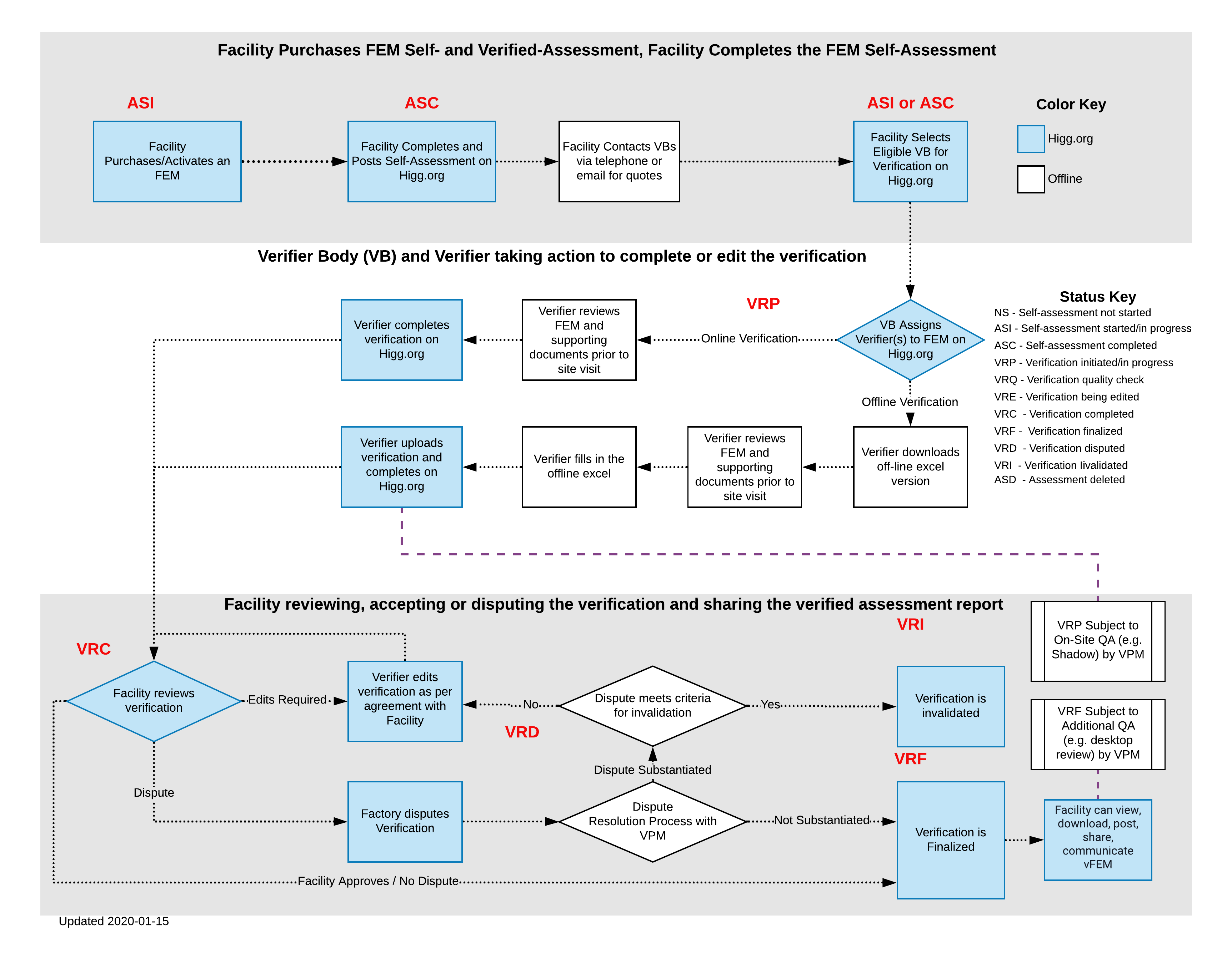Verification Introduction
What is verification?
Verification ensures that you accurately completed all parts of the Higg FEM – giving your self-assessment the credibility and accuracy required to share it publicly.
Verification of the FEM self-assessment is conducted by a third- or second-party Cascale-approved verifier. The verifier is selected and hired to review a facility site. The verifier is the only person responsible for validating the accuracy of the assessment.
Types of Verification
- Onsite Verification: Verifier is required to visit the facility premises. If a facility wishes to publicly communicate Higg Index scoring they must complete onsite verification.
- Offsite Verification: Verifier is able to conduct the verification without going to the site, usually by other means such as e-mail, pictures, web-conference, etc.
Benefits of Verification
There are many benefits for Facilities to be verified by an Cascale Higg Eligible Verifier:
- The Verifier has been vetted to ensure they have proper experience and knowledge. Each Higg Eligible Verifier must:
- Have education in an environmental-related field
- Have knowledge of Environment laws, regulations, and systems
- Have extensive experience in the verification on Environmental aspects in factory settings
- The Verifier has received in-depth Higg training and passed a final exam and are therefore well-qualified to ensure questions are accurately answered and comparable from one facility to another.
- Official Verified results are captured on Higg.org and can be:
- Shared with business partners in lieu of having another verification conducted, therefore reducing or eliminating “audit fatigue”
- Tracked, though time, demonstrating year-over-year improvement
Higg FEM Verification and Quality Assurance
Higg FEM Verification Protocol. The protocol outlines the verification mindset, details on onsite and offsite verification, person-day guidance for conducting verification and many such important details. CY2024 – Higg FEM4.0 Verification Protocol This Protocol document, effective from 1 January 2024, provides more details about Core Verification which applies for CY2024.Verification Protocol Higg FEM3.0
This Protocol document applies to CY 2022 and previous cadences.
Higg FEM Ethics Integrity Protocol
This document outlines how Cascale/VPM will conduct ethics investigations and provides contact details to reach out to if any stakeholder would like to report ethics issues.
Higg FEM Verification Quality Assurance Manual
This Quality Assurance Manual describes the quality assurance (QA) activities that are applied for the Cascale Higg FEM Verification Program. QA activities are designed to ensure a qualified pool of Cascale approved verifiers is available to Higg FEM users, and to ensure quality and integrity during the Higg FEM verification process. It includes a description of the goals and expected outcomes of QA processes and the specific procedures that define how QA activities are executed.
The purpose of Higg FEM QA is to provide high level oversight of Higg FEM Verification and to evaluate whether the verification process is producing consistent and accurate outcomes as per the related protocols and procedures, instead of focusing on the accuracy of particular assessments (Note that QA is not focused on the accuracy of specific verified assessments).
In case you have questions, write to us at support.worldly.io.
Protocols and Guidance for Verifier Bodies
Higg FEM VB and Verifier Requirements Protocol
This document outlines the requirements that Cascale approved Higg FEM Verifier Bodies (VBs) must meet to maintain their status as approved VBs in the Cascale Higg Facility Environmental Module (FEM) Program.
Higg FEM Verifier Code of Professional Conduct
This document outlines the requirements that Cascale approved Higg FEM Verifier Bodies (VBs) must meet to maintain their status as approved VBs in the Cascale Higg Facility Environmental Module (FEM) Program.
Higg FEM Verifier Status Maintenance (VSM) Protocol
This document outlines the requirements verifiers need to meet in order to maintain their status as a verifier.
Higg FEM Verifier Training Protocol
This document outlines the training verifiers will go through upon approval as a verifier, exam they need to complete and details about the post training survey.
Higg FEM Verifier Body List: This is the most updated list of approved FEM verifier bodies along with their contact information and regions of operation.
Higg FEM Verifier Body List: https://howtohigg.org/verifiers
Verification Workflow
See here the visual representation of the Verification workflow and the different FEM assessment status (see status key) that will be indicated on the Worldly platform on the FEM dashboard.
Additional Guidance
Higg FEM3.0 Guidance:
- Guidance for Verifiers: Additional information and helpful guidance for completing the FEM verification.
- Guidance for Facilities: Additional information and helpful guidance for completing the FEM self assessment and verification process.
Higg FEM4.0 Guidance:
- Coming Soon!
Fee Schedule for Verifier Bodies
This document outlines the fees schedule required to be paid by Verifier Bodies.
FEM Training Program
Cascale has a program in place to approve third party training bodies to provide onsite and online training on the Higg FEM to facility users.
FEM Training Protocol
The FEM Training Protocol contains procedures necessary to execute FEM Training by Cascale Approved Trainer Bodies.
Download Higg FEM Training Protocol – Provision of ELearning
Trainer Status Maintenance Protocol
Trainer Code of Professional Conduct
Cascale expects individuals vetted and approved through the Training Program Manager to follow the principles outlined in the Cascale Training Provider Code of Professional Conduct.
This document outlines the requirements that Cascale approved Higg FEM Trainer Bodies (TBs) must meet to maintain their status as approved TBs in the Cascale Higg Facility Environmental Module (FEM) Program.
Verifier Bodies
Please see here the full list of Verifier Bodies who can perform Higg FEM verification, coordinated through Verification partner Sumerra.
If you are a facility: Please use the list to find a Verifier Body. You can then contact the Verifier Body for availability and a quote.
If you want to act as an Cascale FEM Verifier Body or Verifier: Navigate to the Verifier Body list if you want to apply for becoming a Verifier Body for the Higg FEM.
Verification One-Pager
Cascale Member and VB FAQs: Verification Access Fee
The Higg FEM Verification Access Fee is used by Cascale (formerly Sustainable Apparel Coalition) to support the ongoing content and methodology development of the Higg Index, associated programs, and verification protocols, which are essential to drive collective action in the industry. The purpose of these FAQs is to provide Cascale members and Verifier Bodies with information on the Verification Access Fee process for Higg FEM. The collection process for the Verification Access Fee for Cascale members has changed from the previously communicated process.

